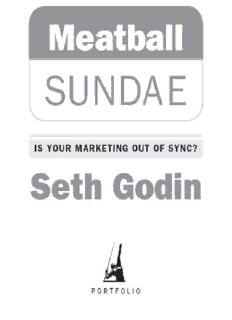
Meatball Sundae: Is Your Marketing out of Sync? PDF
Preview Meatball Sundae: Is Your Marketing out of Sync?
Meatball SUNDAE IF YOU’VE ENJOYED MEATBALL SUNDAE, CHECK OUT THESE OTHER THOUGHT-PROVOKING, BESTSELLING BOOKS BY SETH GODIN: The Dip Small Is the New Big All Marketers Are Liars Free Prize Inside! Purple Cow Unleashing the Ideavirus Permission Marketing Survival Is Not Enough The Big Red Fez AND CHECK OUT THESE FREE E-BOOKS (GOOGLE ’EM): Knock Knock Who’s There Everyone’s an Expert The Bootstrapper’s Bible Meatball SUNDAE IS YOUR MARKETING OUT OF SYNC? Seth Godin PORTFOLIO PORTFOLIO Published by the Penguin Group Penguin Group (USA) Inc., 375 Hudson Street, New York, New York 10014, U.S.A. • Penguin Group (Canada), 90 Eglinton Avenue East, Suite 700, Toronto, Ontario, Canada M4P 2Y3 (a division of Pearson Penguin Canada Inc.) • Penguin Books Ltd, 80 Strand, London WC2R 0RL, England • Penguin Ireland, 25 St. Stephen’s Green, Dublin 2, Ireland (a division of Penguin Books Ltd) • Penguin Books Australia Ltd, 250 Camberwell Road, Camberwell, Victoria 3124, Australia (a division of Pearson Australia Group Pty Ltd) • Penguin Books India Pvt Ltd, 11 Community Centre, Panchsheel Park, New Delhi–110 017, India • Penguin Group (NZ), 67 Apollo Drive, Rosedale, North Shore 0745, Auckland, New Zealand (a division of Pearson New Zealand Ltd.) • Penguin Books (South Africa) (Pty) Ltd, 24 Sturdee Avenue, Rosebank, Johannesburg 2196, South Africa Penguin Books Ltd, Registered Offices: 80 Strand, London WC2R 0RL, England First published in 2007 by Portfolio, a member of Penguin Group (USA) Inc. Copyright © Do You Zoom, Inc., 2007 All rights reserved LIBRARY OF CONGRESS CATALOGING IN PUBLICATION DATA Godin, Seth. Meatball sundae: is your marketing out of sync? / Seth Godin. p. cm. ISBN: 1-4295-9758-5 1. Marketing—Management. 2. Marketing—Social aspects. 3. Product differentiation. 4. Target marketing. I. Title. II. Title: Is your marketing out of sync? HF5415.13.G564 2008 658. 8—dc22 2007023690 Without limiting the rights under copyright reserved above, no part of this publication may be reproduced, stored in or introduced into a retrieval system, or transmitted, in any form or by any means (electronic, mechanical, photocopying, recording or otherwise), without the prior written permission of both the copyright owner and the above publisher of this book. The scanning, uploading, and distribution of this book via the Internet or via any other means without the permission of the publisher is illegal and punishable by law. Please purchase only authorized electronic editions and do not participate in or encourage electronic piracy of copyrightable materials. Your support of the author’s rights is appreciated. A Sundae? Maybe this is familiar. It is to me, anyway: You go to a marketing meeting. There’s a presentation from the new Internet-marketing guy. He’s brought a fancy (and expensive) blogging consultant with him. She starts talking about how blogs and the “Web 2.0 social media infrastructure” are just waiting for your company to dive in. “Try this stuff,” she seems to be saying, “and the rest of your competitive/structural/profit issues will disappear.” In the last ten years, the Internet and radical changes in media have provided marketers everywhere with a toolbox that allows them to capture attention with seemingly little effort, planning, or cash. Six years after the dot-com boom, there are more Web sites, more e-mail users, and more viral ideas, online and offline, than ever before. There are hundreds of cable TV networks and thousands of online radio stations. Not to mention street marketing, e-mail marketing, and MySpace. Corporations, political parties, nonprofits, job seekers, and yes, even people looking for love, are all scrambling around, trying to exploit the power of these new tools. People treat the New Marketing like a kid with a twenty-dollar bill at an ice cream parlor. They keep wanting to add more stuff—more candy bits and sprinkles and cream and cherries. The dream is simple: “If we can just add enough of [today’s hot topping], everything will take care of itself.” Most of the time, despite all the hype, organizations fail when they try to use this scattershot approach. They fail to get buzz or traffic or noise or sales. Organizations don’t fail because the Web and the New Marketing don’t work. They fail because the Web and the New Marketing work only when applied to the right organization. New Media makes a promise to the consumer. If the organization is unable to keep that promise, then it fails. New Marketing—whipped cream and a cherry on top—isn’t magical. What’s magical is what happens when an organization uses the New Marketing to become something it never used to be—it’s not just the marketing that’s transformed, but the entire organization. Just as technology propelled certain organizations through the Industrial Revolution, this new kind of marketing is driving the right organizations through the digital revolution. You can become the right organization. You can align your organization from the bottom up to sync with New Marketing, and you can transform your organization into one that thrives on the new rules. For Natalie
Description: